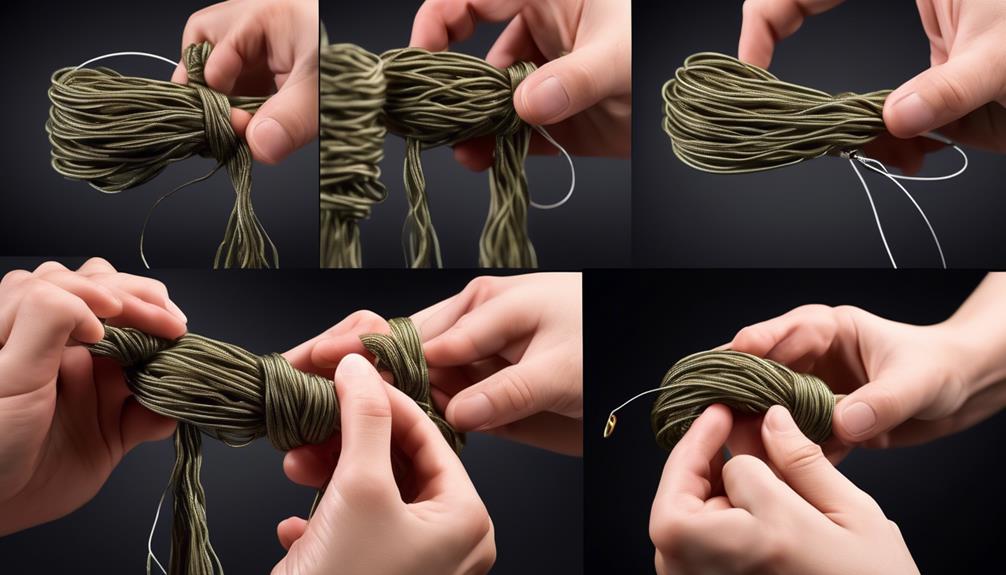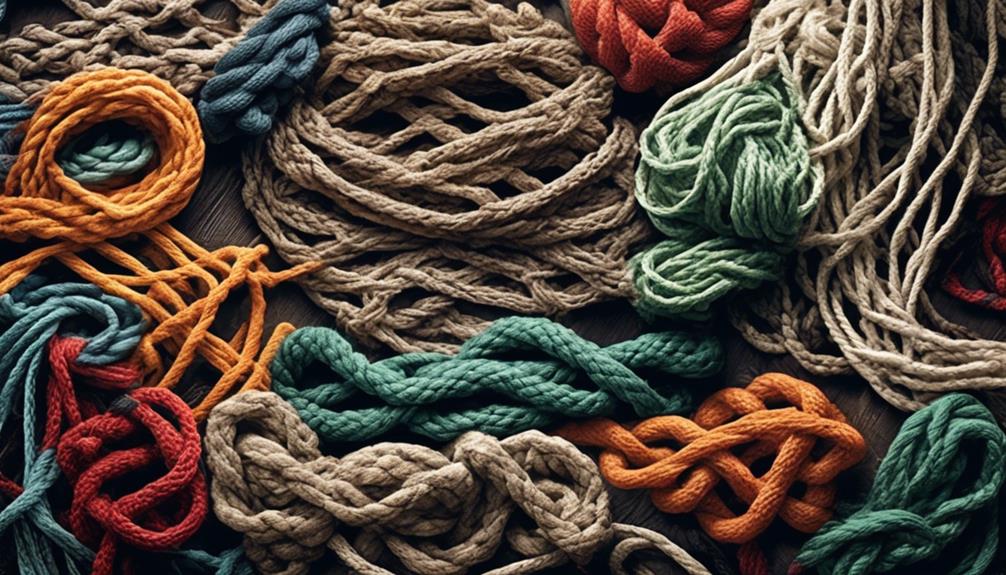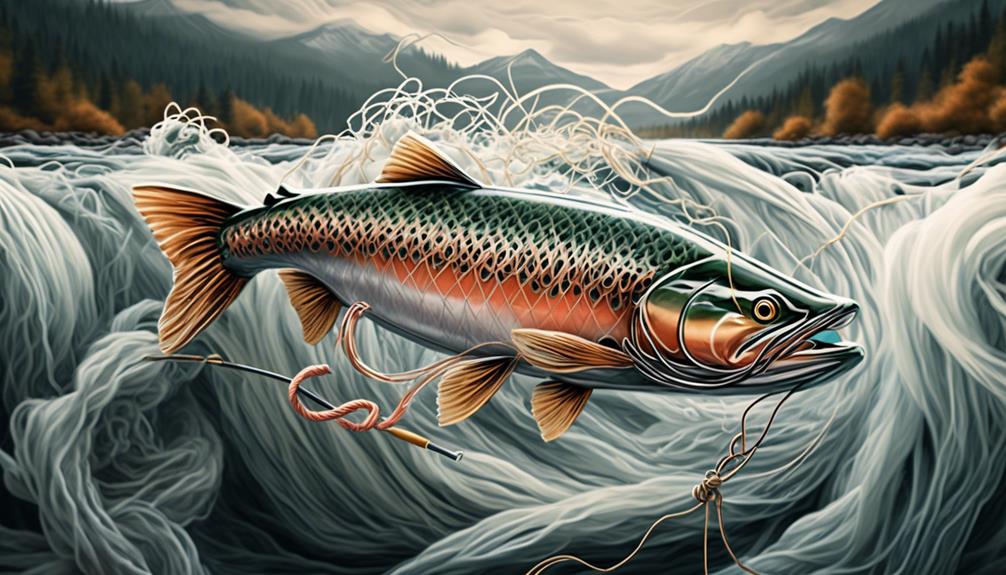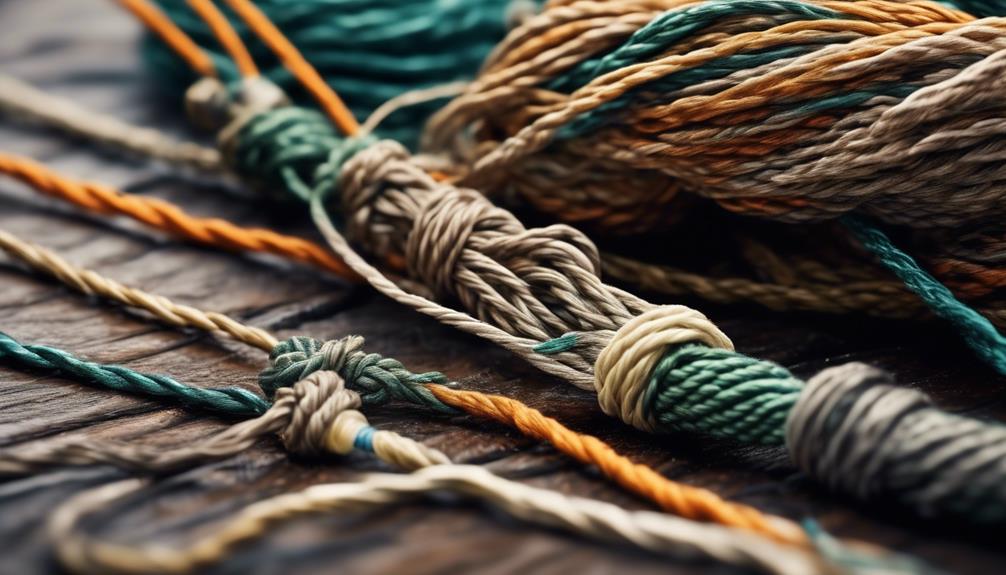You know the saying, 'A bad knot will ruin a good fishing trip.' It's true, isn't it?
So, let's talk about the top 8 fishing knots for braid to leader techniques. Whether you're an experienced angler or just starting out, having a solid grasp of these knots is crucial for success on the water.
Each knot has its own strengths and weaknesses, and choosing the right one can make all the difference between landing that trophy fish or watching it swim away.
So, let's get started on mastering these essential knots that every angler should know.
Improved Clinch Knot
To tie the Improved Clinch Knot, start by threading the line through the eye of the hook and then doubling back to make 5 to 7 wraps around the standing line. Next, thread the loose end of the line through the first loop near the eye of the hook, and then through the big loop. Finally, moisten the knot and pull it tight against the eye of the hook.
The Improved Clinch Knot is known for its knot strength and is one of the most popular and reliable fishing knots.
When it comes to knot strength, the Improved Clinch Knot is highly regarded. Its design allows it to hold up against the struggle of reeling in a big catch. This knot is particularly effective when used with monofilament or fluorocarbon lines. Its simplicity and effectiveness make it a go-to choice for many anglers.
Learning proper knot tying techniques is crucial for any angler. The Improved Clinch Knot is relatively easy to tie and is a fundamental skill for anyone interested in fishing. Mastering this knot and understanding its variations can make a significant difference in your fishing experience. Practice tying this knot until it becomes second nature, as it will serve you well in various fishing situations.
Palomar Knot
The Improved Clinch Knot is a reliable option, but when you need a knot that's equally strong and easy to tie, the Palomar Knot is a great choice for connecting braided line to a leader.
The Palomar knot offers several benefits that make it a popular choice among anglers. One of its primary advantages is its exceptional strength. The knot retains a high percentage of the line's original breaking strength, ensuring that it can withstand the force of large fish without failing.
Additionally, the Palomar knot is easy to tie, making it a practical option for both novice and experienced anglers.
When comparing the Palomar knot to other alternatives, its strength and simplicity set it apart. Unlike some other knots, the Palomar knot maintains nearly the full breaking strength of the line, providing anglers with confidence when targeting large, powerful fish species. Its straightforward tying process also makes it a versatile option for various fishing applications. Whether you're using monofilament, fluorocarbon, or braided line, the Palomar knot remains reliable and effective.
The strength and ease of tying the Palomar knot contribute to its widespread use in both freshwater and saltwater fishing. Anglers frequently rely on this knot when targeting species that require a robust connection between the main line and leader, such as bass, trout, snapper, and tarpon.
Uni Knot
When tying a leader to your braided line, the Uni Knot provides a reliable and versatile option for anglers of all experience levels. The Uni Knot is known for its strength and is widely used in various fishing applications. Whether you're connecting monofilament, fluorocarbon, or braided lines, the Uni Knot is a dependable choice. Its strength lies in the way it cinches down on the line, creating a tight and secure connection. This knot is particularly useful when joining lines of different diameters, making it an essential skill for anglers who frequently switch between different types of lines.
The Uni Knot's strength is derived from its design, which allows it to distribute pressure evenly along the length of the knot. This even distribution of force helps prevent weak points that could lead to line breakage. As a result, the Uni Knot is well-suited for handling the stress of fighting powerful fish, giving anglers confidence that their line connections will hold up under pressure.
In addition to its strength, the Uni Knot has a wide range of applications. It can be used to tie a hook, lure, or swivel to the line, making it a versatile knot for various fishing setups. Anglers can also use the Uni Knot to join different lines together, making it a valuable skill for creating custom leaders or connecting backing to a mainline.
Ultimately, mastering the Uni Knot is a valuable asset for any angler, offering strength and versatility in a wide range of fishing scenarios.
Double Uni Knot
As you move from mastering the Uni Knot, consider expanding your knot-tying skills with the Double Uni Knot.
This knot is especially useful when connecting lines of different strengths, such as joining a braided main line to a fluorocarbon or monofilament leader. The Double Uni Knot is known for its reliability and ability to maintain a significant portion of the line strength, making it a popular choice among anglers who require a strong and secure connection.
To tie the Double Uni Knot, start by overlapping the ends of the lines you want to join. Create a loop with the main line and double the tag end. Then, pass the tag end through the loop and wrap it around both lines and through the loop several times. Moisten the knot and pull it tight, ensuring the wraps are neatly aligned. Repeat the process with the other line, wrapping the tag end around both lines in the opposite direction. Finally, trim the tag ends to complete the knot.
When using the Double Uni Knot, it's important to pay attention to the number of wraps for each line, as this will affect the knot's strength. With a little practice, you'll find that this knot provides a reliable connection, maintaining a significant amount of the line strength for successful fishing endeavors.
Incorporating this knot into your knot tying techniques will enhance your angling experience, especially when dealing with lines of different strengths.
FG Knot
Master the FG Knot, a popular choice for connecting braided line to monofilament or fluorocarbon leaders due to its slim profile and smooth casting performance. The FG knot is highly regarded for its exceptional strength, making it a go-to option for anglers targeting large and powerful fish species. When tied correctly, the FG knot boasts impressive knot strength, often outperforming other knot options for connecting braid to leader.
To ensure optimal performance, it's essential to follow a reliable FG knot tying tutorial to master this essential knot for your fishing endeavors.
One of the key advantages of the FG knot is its ability to maintain a low profile, seamlessly gliding through rod guides for smooth and efficient casting. This knot's slim design reduces the likelihood of snagging or tangling, providing anglers with a hassle-free fishing experience. Additionally, the FG knot's exceptional strength ensures that it can withstand the intense pressure exerted by hard-fighting fish, giving you the confidence to tackle challenging catches without worrying about your line connections.
When learning to tie the FG knot, pay close attention to the fine details of the tying process to achieve maximum knot strength. Proper tension and precise wrapping are crucial for creating a secure and reliable FG knot. By mastering this essential knot, you can enhance your fishing techniques and tackle big game with confidence.
Albright Knot
Would you like to learn how to tie the Albright Knot for seamlessly connecting braided line to monofilament or fluorocarbon leaders? The Albright Knot is a versatile and reliable knot that's widely used by anglers for its strength and ease of tying. This knot is particularly useful when you need to join lines of different diameters, such as connecting a thin, strong braid to a thicker, more abrasion-resistant monofilament or fluorocarbon leader.
The Albright knot strength is one of its key features, as it maintains a high percentage of the line's original strength when tied correctly. This makes it an excellent choice for situations where maintaining line strength is crucial, such as when targeting large, powerful fish species or fishing in areas with heavy cover where the line may be subject to abrasion.
When comparing the Albright knot vs other braid to leader knots, the Albright knot stands out for its simplicity and effectiveness. While other knots like the FG knot and the double uni knot are popular for connecting braid to leader, the Albright knot is often preferred for its ease of tying and reliable performance. Its slim profile also allows it to pass through rod guides smoothly, reducing the chances of snagging during casting.
Blood Knot
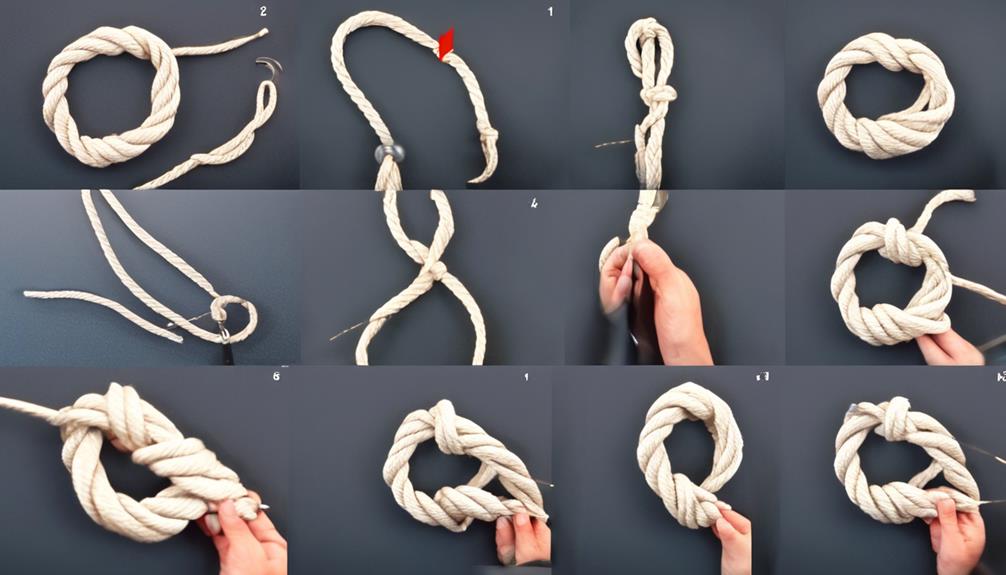
The Blood Knot is a popular choice for joining two pieces of monofilament or fluorocarbon fishing line of similar diameters. This knot is known for its strength and reliability, making it a favorite among anglers for connecting leader and tippet sections.
Here's what you need to know about the Blood Knot:
- Blood Knot Strength: When tied correctly, the Blood Knot offers exceptional strength, allowing it to withstand the forces exerted during the process of reeling in a catch. Its design distributes pressure evenly across the wraps, minimizing the risk of breakage and ensuring that the line remains secure.
- Blood Knot Tying Technique: To tie a Blood Knot, overlap the ends of the two lines you wish to join. Create five to seven wraps around both lines, then pass the tag end through the gap between the lines. Repeat the process with the other tag end, ensuring that the wraps are formed in opposite directions. Moisten the knot before drawing it tight, seating the wraps firmly together to complete the knot.
- Usage Considerations: It's important to note that the Blood Knot is best suited for connecting lines of similar diameters. When tying this knot, ensure that the wraps are neatly formed and that the tag ends are trimmed closely to prevent any interference with the line's movement.
Mastering the Blood Knot will provide you with a reliable connection, enabling you to fish with confidence knowing that your lines are securely joined.
Surgeon's Knot
To tie a Surgeon's Knot, overlap the ends of the two lines you wish to join and create a loop with the doubled lines. Then, pass both ends through the loop twice and tighten the knot by moistening it and pulling the lines in opposite directions.
The Surgeon's Knot is an essential fishing knot known for its simplicity and tying strength. It's commonly used to join two fishing lines of similar or different diameters, making it an ideal choice for creating a secure leader connection.
The Surgeon's Knot is valued for its exceptional tying strength, making it a reliable option when connecting lines. Its design allows for the distribution of pressure evenly along the knot, minimizing the risk of breakage, which is essential when dealing with large or powerful fish. This knot's ability to maintain its integrity under pressure is crucial in ensuring a successful catch.
When creating a leader connection, the Surgeon's Knot is particularly advantageous. It enables anglers to seamlessly attach leaders to main lines, providing a smooth transition that doesn't compromise the overall strength and durability of the line. This is especially beneficial when using a leader with a different strength or material than the main line, as the Surgeon's Knot creates a secure and dependable link.
Frequently Asked Questions
What Are the Best Types of Fishing Lines to Use With Each of These Knots?
For the best fishing lines to use with these knots, consider braid and mono compatibility. Braid works well with knots that require high knot strength, like the palomar or double uni knot.
For knots needing line flexibility, mono is a better choice. Mono is more forgiving and easier to work with for knots like the clinch or blood knot.
Matching the right line to the knot will enhance your fishing experience.
Are There Any Specific Types of Hooks or Lures That Work Best With These Knots?
When choosing hooks and lures to go with your fishing knots, it's essential to consider the type of fishing lines you're using. Different knots may work better with specific hook or lure types, depending on the weather conditions.
For example, in windy conditions, you might want to use a knot that provides extra strength and security for your lures.
Always match your hooks and lures to the specific knots and fishing lines you're using.
How Do You Properly Maintain and Care for Knots to Ensure They Remain Strong and Secure?
To maintain strong and secure knots, it's essential to regularly inspect them for any signs of wear or damage.
Outdoor knot care involves keeping them clean and dry, as dirt and moisture can weaken the knot.
Proper knot maintenance includes retying them if they seem compromised and using the correct technique when tightening.
Are There Any Specific Tips for Tying These Knots in Different Weather Conditions or on a Moving Boat?
When tying knots in adverse weather or on a boat, it's crucial to maintain focus and keep your surroundings in mind. Outdoor knot tying techniques should be adapted to the conditions, like using a secure grip and ensuring the line doesn't get wet.
Safety is key, so be extra cautious. Find a stable spot on the boat and brace yourself against the motion. Always prioritize safety when tying knots in challenging conditions.
Can These Knots Be Used for Other Outdoor Activities, Such as Camping or Hiking, or Are They Specifically Designed for Fishing?
Yes, these knot techniques are versatile and can be used for other outdoor activities like camping and hiking.
The skills you learn from tying these knots for fishing can be applied to securing tents, creating makeshift gear, or even building shelters.
Their adaptability makes them valuable for various outdoor scenarios, enhancing your preparedness and resourcefulness.
Conclusion
So there you have it – the top 8 fishing knots for braid to leader techniques.
With these knots in your arsenal, you'll be well-equipped to handle any fishing situation that comes your way.
Remember to practice tying these knots until they become second nature, and always check your knots for strength and security before casting out.
Happy fishing!
